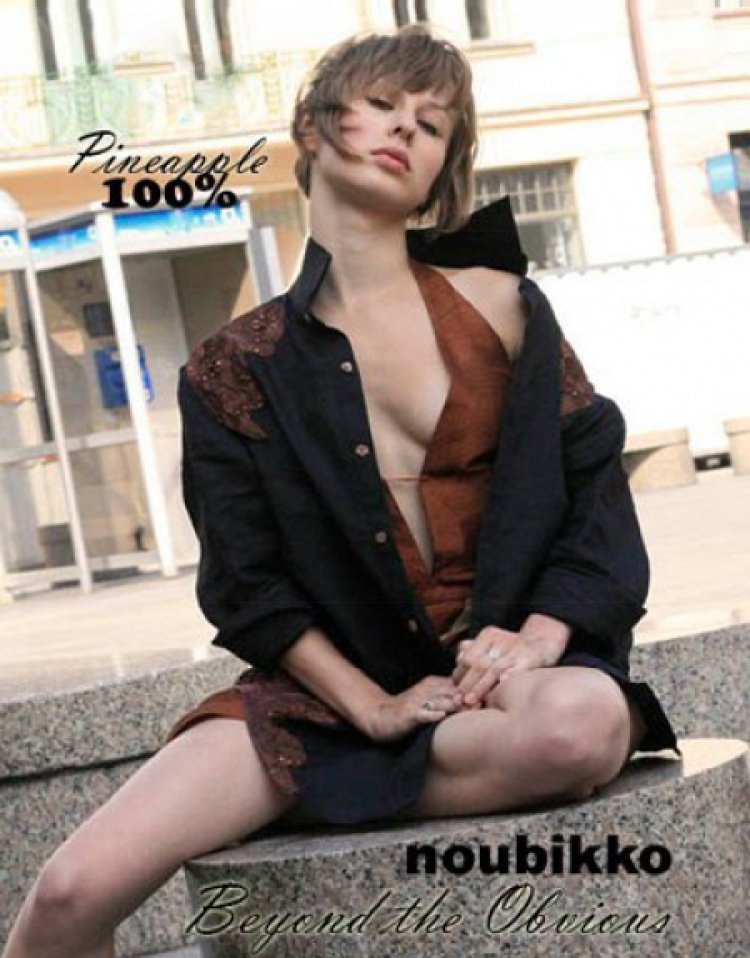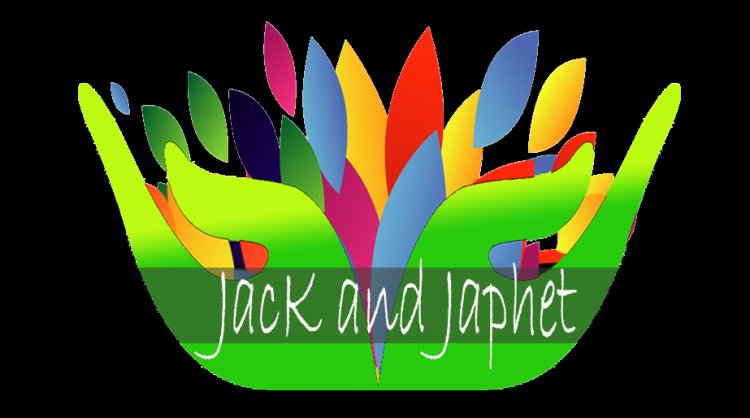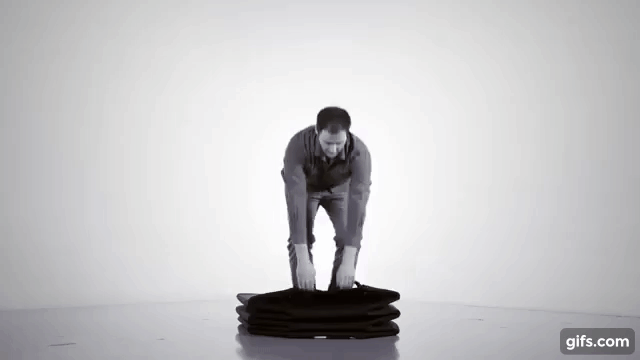Billy Vanilli’s Decadent, Hyper-Real Paintings Look Good Enough To Eat
Through a year of isolating at home during the peak of the pandemic, Billy Vanilli – who trained as a photographer and graphic designer – began exploring oil painting. Creating hyper-real scenes of food kept him company throughout Melbourne’s lockdowns, whilst separated from friends and family. From fresh produce draped in translucent materials, to baroque dinner parties set with cheeseburgers, fries and candelabras, Billy’s decadent, delectable scenery vibrate with colour, energy and flavour. Today we meet this promising young artist, in his Fitzroy studio.

Billy Vanilli’s Decadent, Hyper-Real Paintings Look Good Enough To Eat
Studio Visit
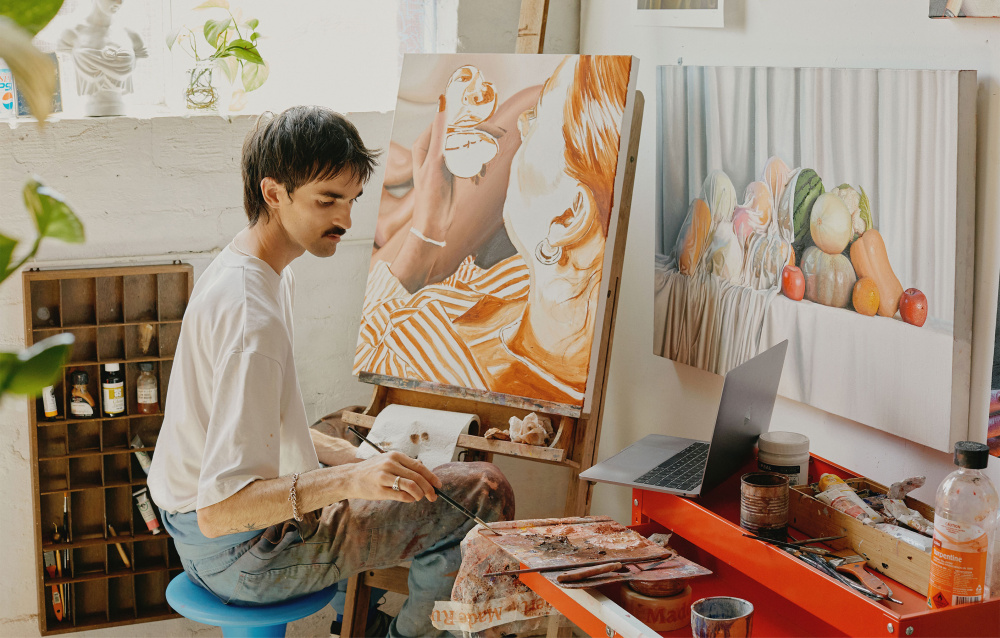
Artist Billy Vanilli works on his latest piece in his Fitzroy studio. Photo – Amelia Stanwix for The Design Files.
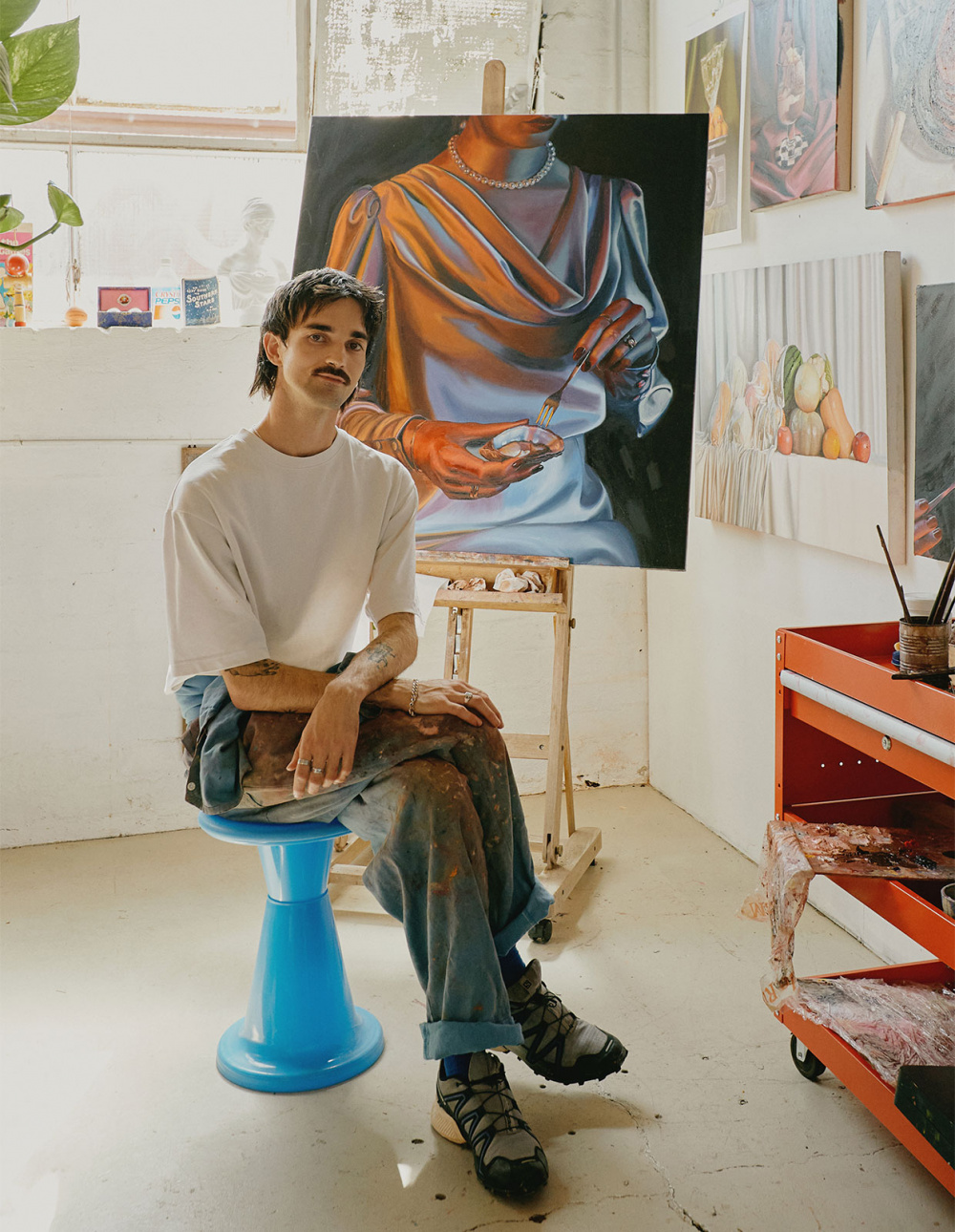
Billy sits in front of his painting, ‘Shucked But Not Forgotten.’ Photo – Amelia Stanwix for The Design Files.
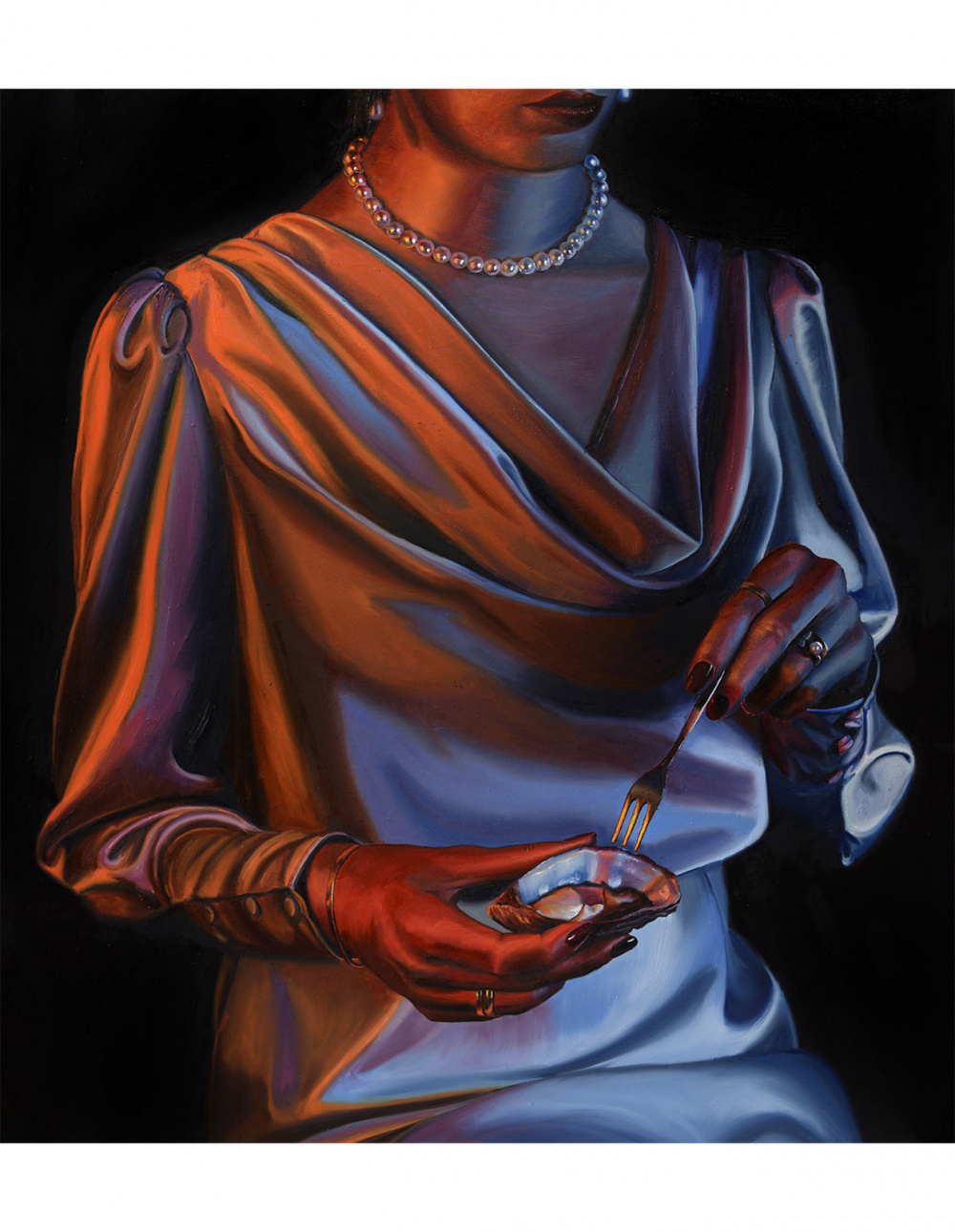
‘Shucked But Not Forgotten’ by Billy Vanilli.
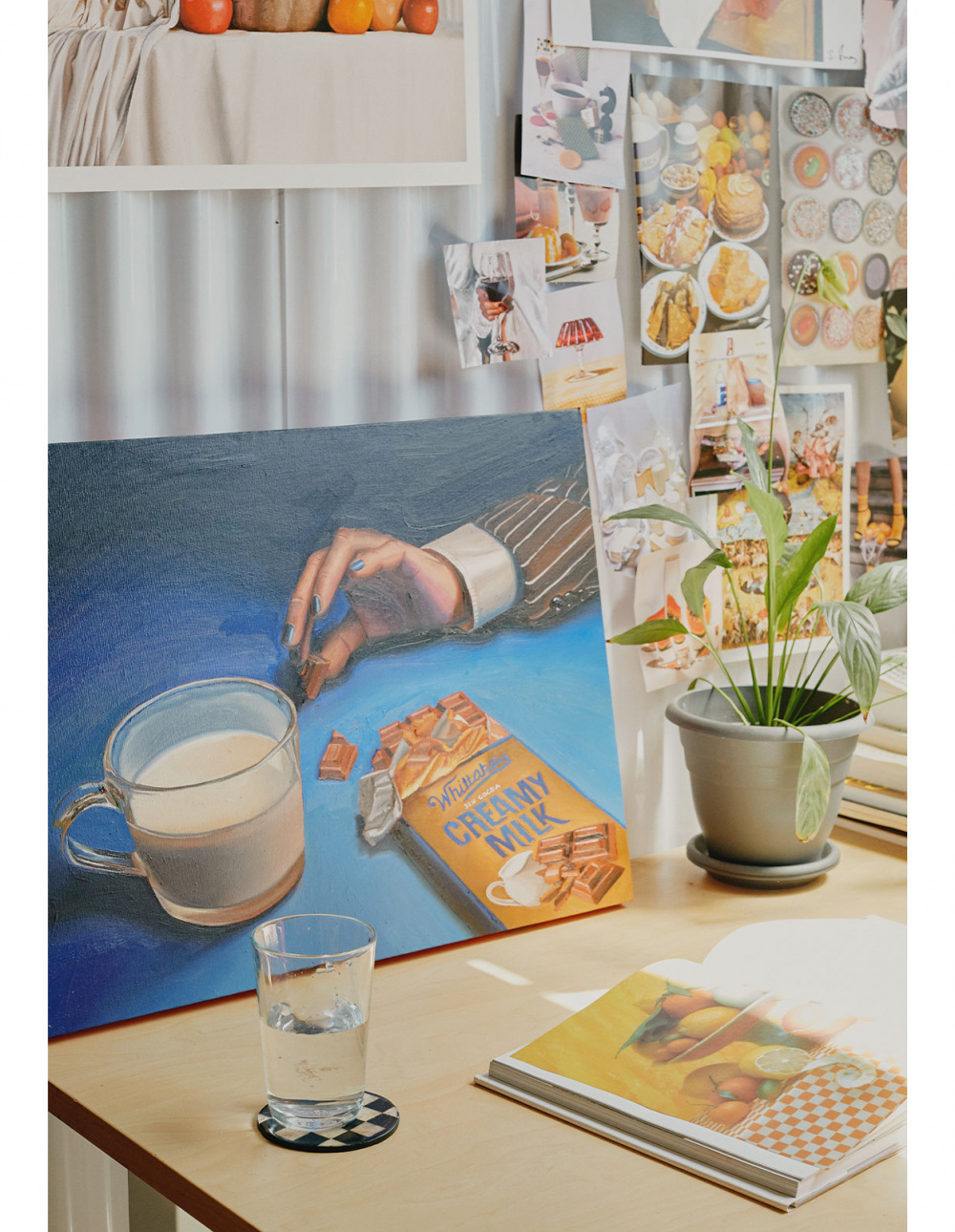
Billy’s oil painting, ‘Midnight Snack’. Photo – Amelia Stanwix for The Design Files.
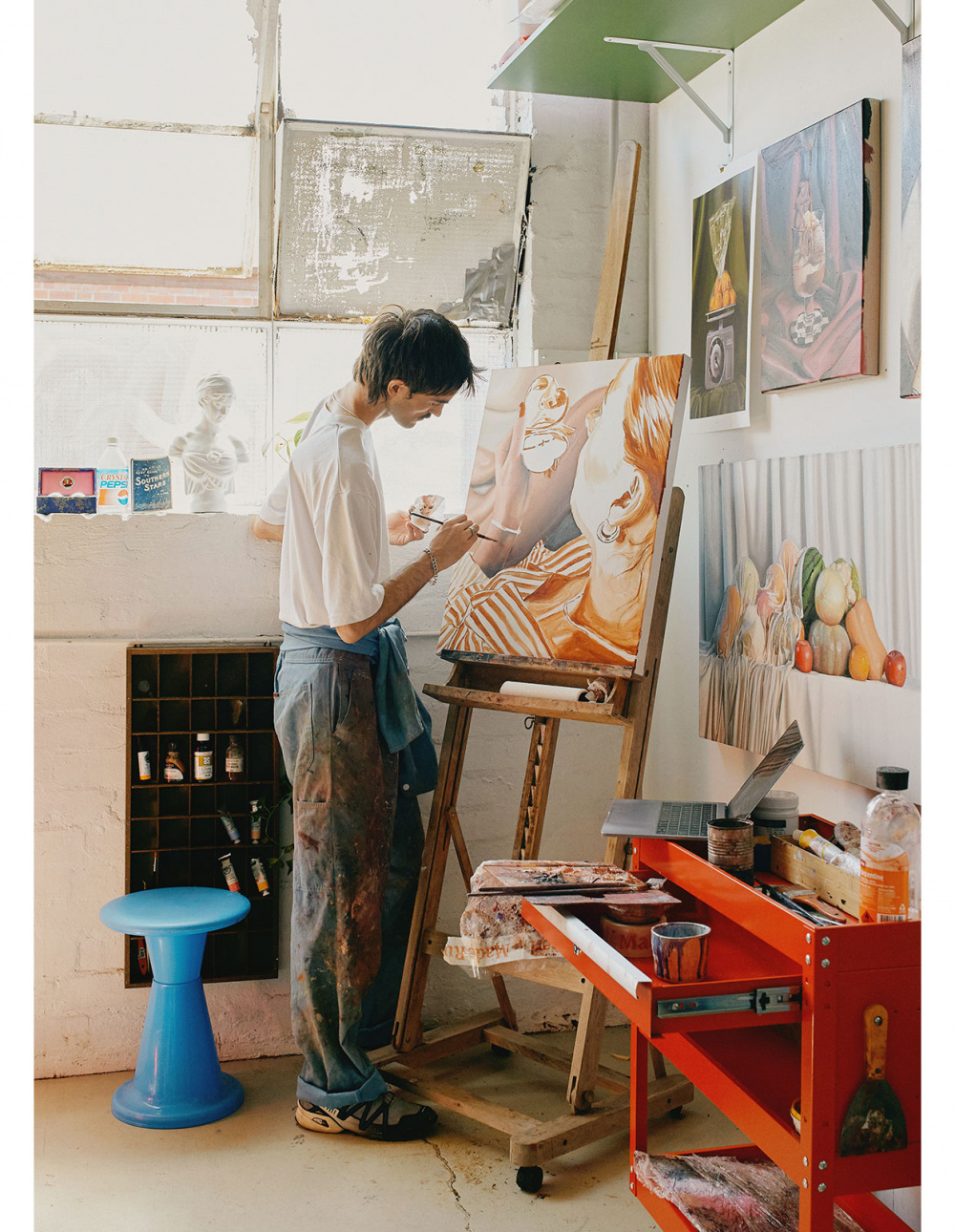
Billy’s painting career started with a lot of late night colour mixing, and trial and error. ‘In 2020 I just picked up the tools, started putting paint to canvas, mixed a lot of the wrong colours, asked a million questions to other artists and eventually my paintings started to take shape,’ he says. Photo – Amelia Stanwix for The Design Files.
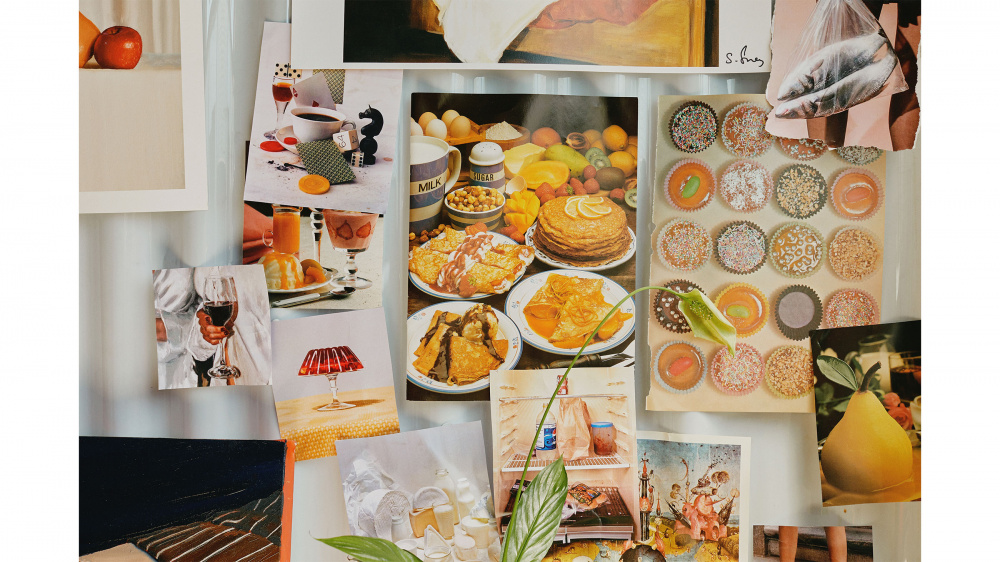
Billy’s subjects are mostly food, in still-life, but more recently he has begun to introduce a human element to his works. Photo – Amelia Stanwix for The Design Files.
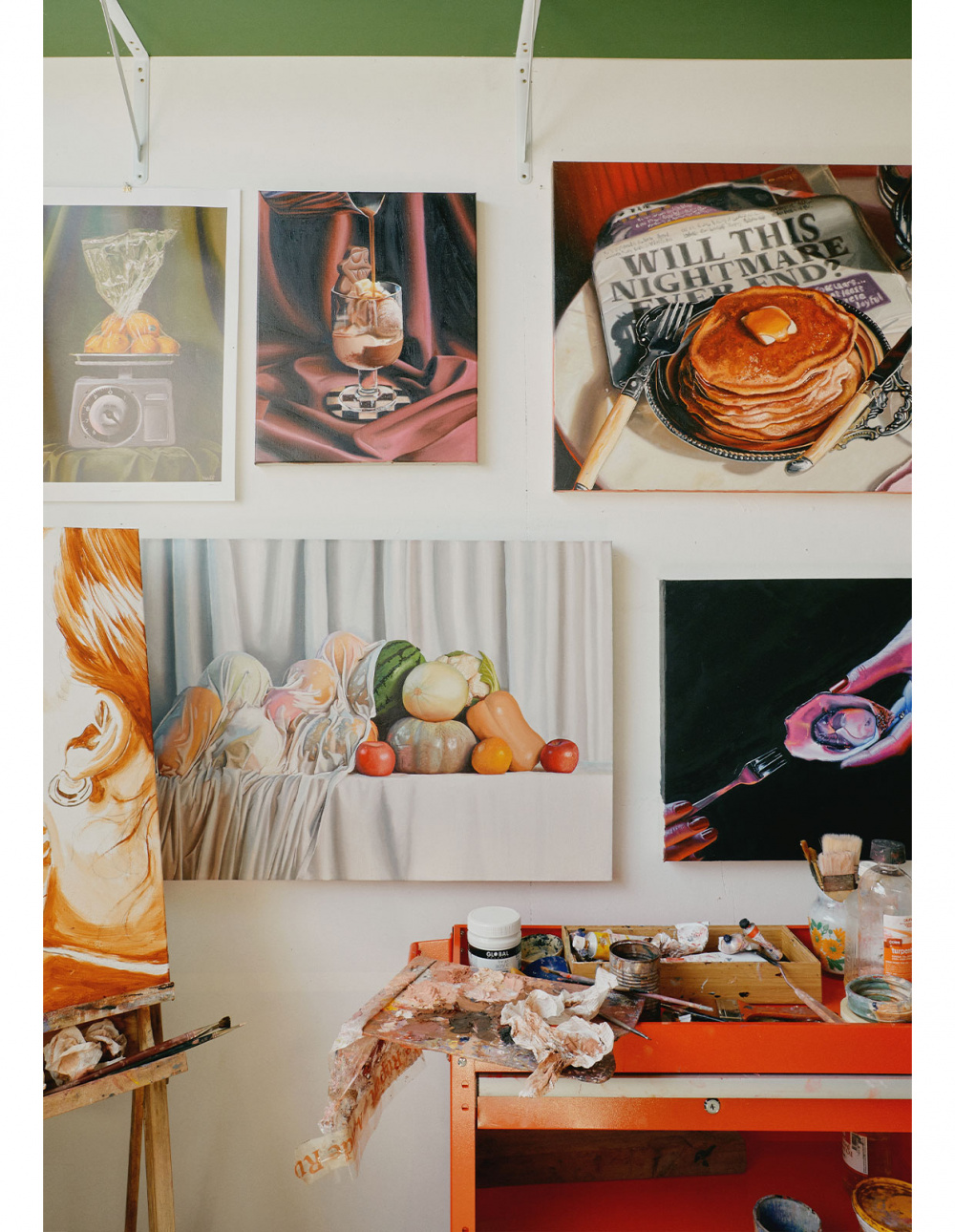
Clockwise from top left; ‘Lemons‘, ‘Affogato al Freddo’, ‘Will This Nightmare Ever End?’, ‘Aphrodisiac’, and ‘Wet Produce‘. Photo – Amelia Stanwix for The Design Files.
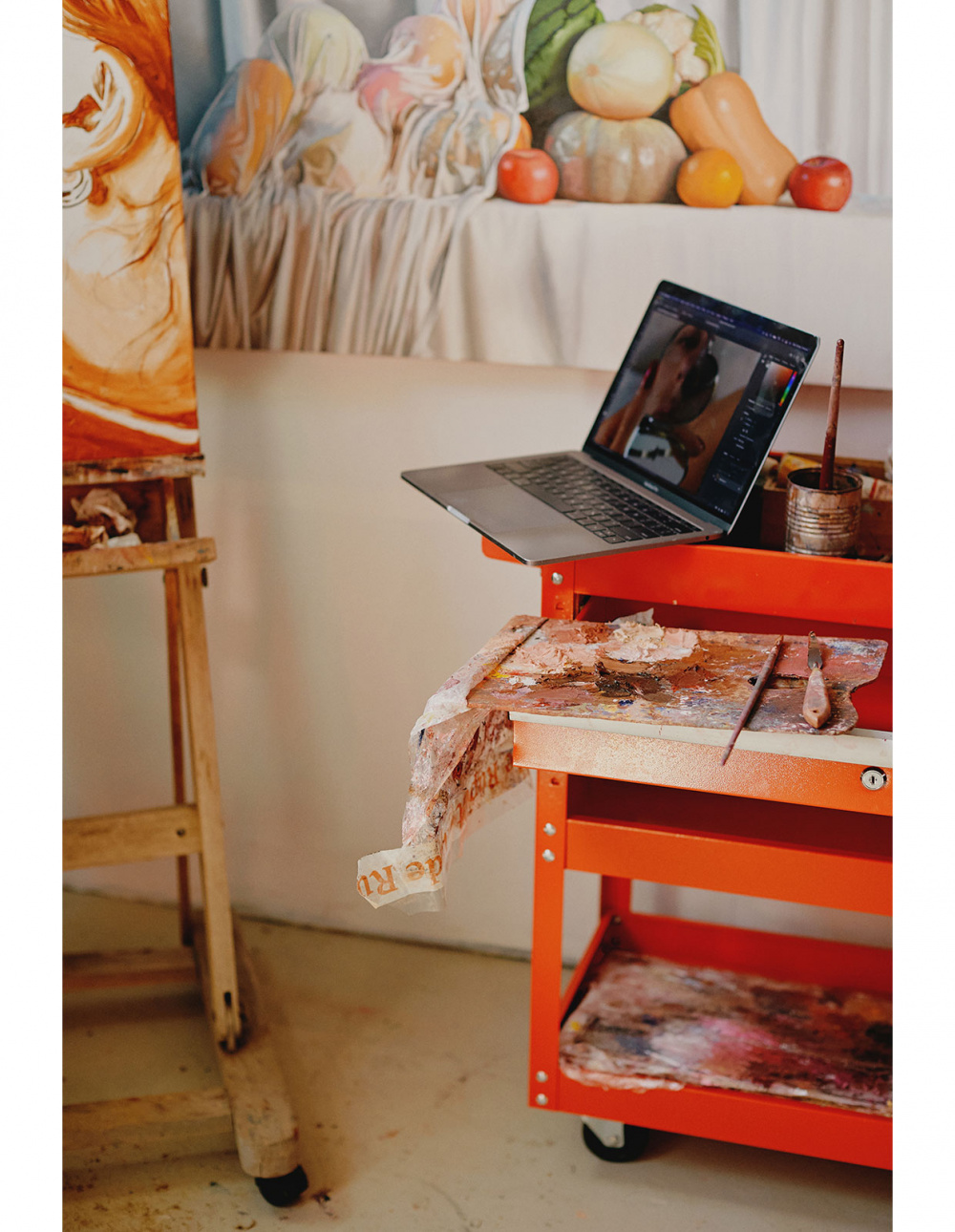
Billy only uses five pigments in his palette. ‘This means there’s a fair bit of time spent on colour mixing, but it results in the colours being really harmonious,’ he explains. ‘Great for realism.’ Photo – Amelia Stanwix for The Design Files.
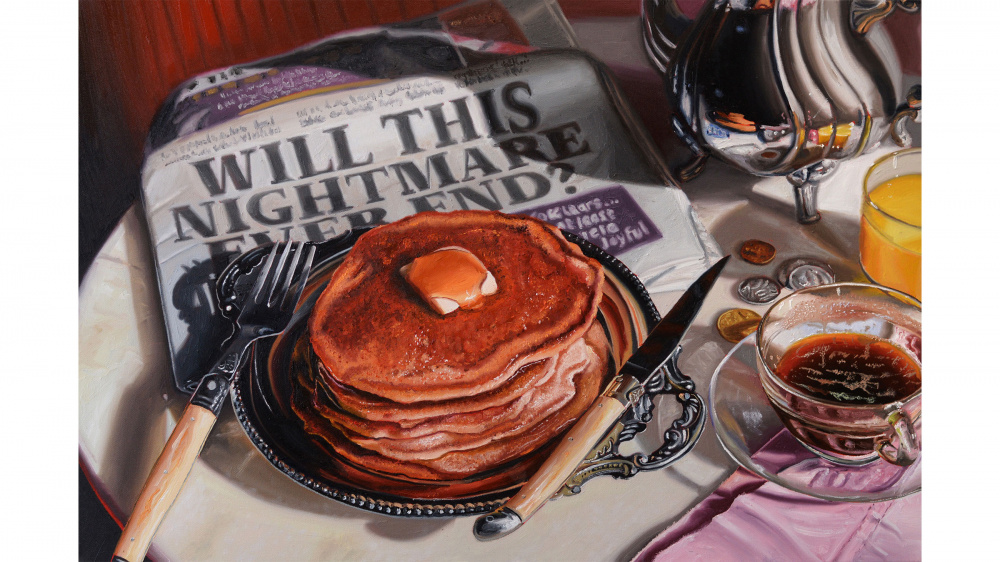
‘Will This Nightmare Ever End?’ by Billy Vanilli.
Astoundingly, Billy Vanilli only picked up a paintbrush formally in 2019 when, on a whim, he booked into beginner’s painting classes at Fitzroy Painting. Despite this initial spurt of training, it took a global pandemic to really kick him into a fully fledged art practice.
Billy soon started to shed his day hours as a graphic designer, and spent his time at the canvas instead, slowly developing his style and building up a body of work, as lockdowns silenced all other distractions.
‘I was surprised by my patience; something I had previously lacked in most areas of my life,’ he says. ‘It sounds pretty cliché but it became very meditative, something that would slow down my brain. Two years later and I’ve painted almost every night since.’
Billy’s methodical, consistent application of ideas and images to canvas has resulted in a practice that is composed and unique. With three upcoming shows this year (a group show at MILK in March, another at Goodspace in April, and a solo show in the second half of the year), we’re predicting big things for this promising young painter!
Read on for more about Billy’s life, art and practice.
You’re a completely self-taught painter, which is incredible considering how intricate and hyperreal your paintings are. Was it a deliberate choice not to study painting formally?
Thank you, that’s very kind. There was a lot of late night colour mixing and trial and error! But it really doesn’t feel like I’m self-taught. I have had so much advice, guidance and help along the way. That was a silver lining of pursuing this practice during a pandemic; it became very natural to reach out to people you admire online. As well as going into it equipped with some colour knowledge from my design career and the few painting classes I had done.
Formal study has crossed my mind but I decided against it. Some of the painting courses that tertiary institutions offer doesn’t sit right with me. I’ve spoken about this a lot with friends who have studied recently. There seems to be value in the industry connections you can make but it also seems it can be a bit restrictive, pushing you in a certain direction creatively. Don’t get me wrong, I believe it’s very important to be challenged and pushed away from your style; but I guess I just want to take this journey on my own terms.
However, I’m definitely interested in other avenues of learning, such as a mentorship, residencies or short painting classes here and there. There are also so many amazing resources out there that don’t end in debt. So for now, I’m happy consuming art books, podcasts, films, tutorials and annoying other artists to steal all their secrets.
How did you go about discovering your style?
I still feel like I’m still discovering a style, and I think it’s necessary to always feel that a little bit. If I personally felt I had reached a style that was so distinctly mine, then that signals to me that I’m not challenging myself or experimenting enough. That’s where I get the most fun out of painting; experimenting, trying something new, always learning.
Saying that, my discovery to where I am began with consuming a lot of art over the years. Then, in 2020 I just picked up the tools, started putting paint to canvas, mixed a lot of the wrong colours, asked a million questions to other artists and eventually my paintings started to take shape.
I have mostly painted still life up until now. It just felt like the right place to begin learning traditional painting techniques. It was also much easier to gather together some fruit and a candelabra during lockdown rather than a life model. More recently, I have been introducing human elements into these still life scenes. This happened pretty naturally.
Is this what you do full time? If not, what else do you do?
This year I’ve began making the transition to full-time painting. Initially I worked as a graphic designer full-time and I would only paint at night once I got off work. Then, when lockdowns ended I remembered what a social life was… so this balance didn’t work so well anymore. Just last month I’ve cut back on my design work – allowing a lot more time for painting and seeing friends!
Can you tell us about the space in which you typically create?
I work from a dusty old warehouse in Fitzroy. It gets beautiful natural light but that also means it gets very hot. The space isn’t huge but I generally only work on 1 or 2 paintings at a time so it’s perfect for me. It also has city views if you twist your head on the right angle!
What is the process of actually making one of your paintings?
My paintings are all done in oils. I work with a limited palette which means I just use five pigments. This means there’s a fair bit of time spent on colour mixing, but it results in the colours being really harmonious, great for realism. I’ve used the same eight or so brushes for the last two years – I probably need new ones but hey they work fine!
The process of creating the artwork starts with jotting down ideas, scenes or something that pops into my mind. I eventually translate this initial idea into photography. I set up a scene, often roping in a reluctant friend or my partner to hold some props or drapery. I take photos of the scene from different angles and lighting conditions. Then, working from the reference photos I create an underpainting, building up tone. After that, I paint. Sometimes I will use big brush strokes filling the space fairly quickly and other times I will just intricately work on one section at a time.I usually spend about 2 weeks on the smaller works and a month on the bigger pieces.
Food is a constant thread throughout your work. What are you drawn to this as a main subject matter?
Who doesn’t love food? The theme happened pretty naturally. I was away from all my friends and my partner for the first 6 months of the pandemic. This resulted in a lot of dining in solitude. Something I hadn’t really done much before. I really missed sharing a meal with friends. So, painting food became a way for me to visually share a meal with people. Much like you would have friends around and cook for them, I enjoyed watching them devour something I had worked hard over. This has since evolved into exploring specific themes around the eroticisation of food and the unique ways people behave when in acts of consumption.
I’m also fortunate to live with a partner who is an amazing cook and very knowledgeable in the world of food and art history. I’ve learned a lot from her, like culinary wonders I didn’t know existed. A lot of the ideas spark just from talking, eating, watching or cooking food together (still working on that last one).
Other than food, do you have any key references or inspirations?
Can I mention food magazines? I love looking through the old 80s/90s cookbooks and food publications. I often refer to Irving Penn and his food photography he’s done for Vogue over the years. I’ve been forever fascinated with the worlds of Bosch and Bruegel. Probably the two artists that got me interested in observing painting early on.
Edward Hopper’s work has been a key reference for some of the more figurative stuff I’ve been working on lately. Agnes Martin, which may come as a surprise, being as far away as you could get from my world of realism, but something about her work always intrigues and relaxes me.
There’s also plethora of incredible contemporary artists I’ve discovered over the past few years that I’m constantly inspired by. Some being Issy Wood, Roxanne Sauriol Hauenherm, Shannon Cartier Lucy, Tom Ferson, Anna Weyant, Sam McKinniss, Mia Middleton and Tully Moore. I could go on forever, but there’s a few favourites.
It can also be something as simple as drawing inspiration from an object. I have a bit of a habit of scouring auction sites and op shops for unusual things. Often ideas originate from there.
Lastly, my Mum – I don’t know if I would be painting If I didn’t grow up around the smell of oils and turps. She was the first person I shared my first paintings with and is still the first I share each with.
What does art-making mean to you, and what do you hope to communicate?
Art-making for me is just about having fun, feeling relaxed but also engaged. I really don’t have ambitions to disrupt the art world with my paintings or anything. I just want to paint whatever occupies my mind at the time, kind of like keeping a diary. It’s something I started for myself to feel better at a time I wasn’t feeling so great and I always want to hold onto that.
Once it’s out in public, it’s no longer for me. By then I’ve spent long hours with the work and it’s served its purpose.
People are then welcome to look at the work and feel joyful, confused, hungry, angry, horny, nostalgic or nothing at all! I don’t really mind, I have my ideas I’d like to communicate but I don’t want that to inform someone else’s interpretation.
See more info about Billy here.









